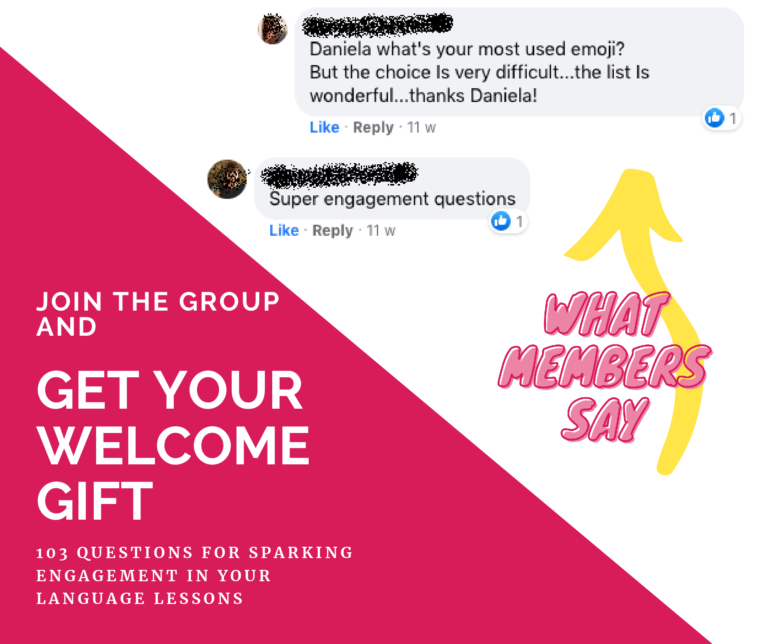
Many topics to cover, tons of ideas, a number of drama exercises you would like test out. Where to start from? Course planning by drama can be overwhelming, unless you know how to simplify the planning.
In this article you’re going to learn the 7 basic steps for planning the perfect 1-year language by drama course.
What’s the difference between course outlining and lesson planning?
First of all, let’s get clear on the difference between course outlining and lesson planning. When we outline a course we put down the foundations of the course, its milestones and main features. The purpose of course outlining is to get clear on our students’ needs, on the course goals, on the expected results as well as on how we want to measure those results.
When we plan lessons, we want to micro-design each single lesson. In other words, we set the specific goals for each lesson, we pick the content specific for each lesson, we decide on the methods, exercises and activities we will be proposing in each lesson.
This article wants to focus on course outlining. If you are looking to outline a 1-year course, for instance, the following guidelines are very helpful. I tried to breakdown the whole outlining process into seven basic steps, so that you can start to dance straightaway!
That is why the guidelines in this article are helpful for both language teachers with some experience in language teaching through drama and language teachers who have just started out.
Phase 1 – Set the framework of your course
Let’s begin by setting the framework of your language course. You will do that in four steps:
- Get clear on who your students are, on their needs, as well as on their entry level
- Set goals and results you can actually expect
- Choose a suitable textbook, pick the units you want to cover. Textbooks usually provide you with all the content related to each unit of the programme (grammar functions, vocabulary, etc.). You will decide later if your students need to get that textbook or not – this is not relevant at this stage. Some teachers love to pick the units from different textbook: that’s absolutely alright and, if you want to go for that approach, just remember to collect all the units together in order to get a clear idea of all the units you are going to work on. I recommend to choose any textbook based upon the communicative approach for language teaching. According to the communicative approach, usually each unit covers a topic that helps to explore specific grammar structures, vocabulary and communicative functions. For example:
- Unit: At the train station.
- Topic: travelling, interactions at train stations.
- Communicative functions: asking for information, providing with information, complaining about something.
- Grammar: question structure, verb tenses, verb modes (according to the level and the language you teach, you will decide what falls within)
- Vocabulary: lexis related to the interactions at the train stations.
- Decide on the time you want to dedicate to each unit.
- Decide on how you are going to measure and evaluate your students’ progress.
If you have to deliver a programme someone else gave you (the school you work for, for instance), usually the outline is ready-made. Lucky you! If this is your case, you can skip Phase 1.
Phase 2- Let’s spark drama
At this point, you’ve got the programme taken from your textbook. The programme consists of acquisition units. Now, let’s add drama to the output of the first phase.
You can do that in two ways:
- By designing stand-alone acquisition units based on drama approaches (see post about the seven drama approaches for language teaching & language lesson planning]
- By creating one big, harmonic programme linking together the acquisition units.
This post explores how to design one big, harmonic programme.
Following up on the fifth step of phase 1, you will now:
6. Think about the acquisition units as episodes of a story. Make up a story that links together the units: who are the characters? In which context do they act? What are the dynamics within the group of characters? What happens that creates tension (the reason for the story to deploy)?
7. For each episode, put down what happens in brief: where the characters are, what problem they need to solve (mission to accomplish), what the expected output is.
The guidelines in the steps 6 and 7 come from Process Drama. I chose to pick what I think it is essential to put in the outline of a language course in order to avoid you to get stuck at this stage of the process. In my experience, when I teach this approach to language teachers, I see they find it easier to outline courses.
Here is an example for what I mean.
- “At the station” unit/ episode.
- Students will be a team of journalists.
- Teacher will play the role of the coordinator of the team.
- What happens in the episode: journalists have to get off the train where they are travelling due to a technical issue. They are at the train station in a small town they don’t know and they need to get to destination as soon as possible. People at the station seem not to be friendly and are not keen on helping.
- Expected output: they manage to find out what the technical issue was, what is the next available train they can take to get to their destination and why the people at the station don’t want to help the journalists.
Output: your language course based on drama outlined
Once you come up with an answer to the seven steps by following the guidelines above, your language course is officially outlined: congratulations!
You now have a framework, goals and expected results, the milestones of your course. You also have a list of units you will be covering in your programme and the timing you will be delivering each unit. Furthermore, you have a textbook that gives you resources and instructions around the units and the topics you will be exploring.
Ultimately, you have got a story through which your students will be exploring the topics as well as the grammar/ vocabulary content related to those topics. In the story, each unit corresponds to an acquisition unit.
What’s next?
I know many language teachers will be guessing at this point: “What’s next??”. Understandable. In fact, once the outline is done, the next task is to come up with the lesson plan for each unit (or episode, in the story we made up).
Even though this is not the main object of this article, I want to give you at least a few major insights about language lesson planning through drama.
So, you came up with the outline of your programme. Now, it’s time to delve into each episode and plan the lessons.
I am going to write an article about lesson planning by drama. For now, try to keep the planning as simple as you can and to stick to what your textbook provides you with in terms of material and resources.
What to do in order to embody drama in lesson planning
When it comes to lesson planning and you want to embody drama exercises, this is what I suggest to do:
- Start from each activity proposed by the textbook and think about a way you can embody it within the story of each episode
- Use the resources and the material your textbook provides you with. The only thing you will need to do is to reframe those resources within your story
- If have just started out with drama approaches, choose to propose mainly games, basic role-play and creative writing activities.
Example
In your textbook, the unit “At the station” starts with a dialogue. Specifically, there is an audio-track of the dialogue followed by a grid-cloze for helping the global comprehension. The students are invited to listen to the dialogue and to fill in the grid-cloze. This is what you have according to your textbook and that will be your starting point. You can turn that phase of the unit into a drama activity within the story you created. How could you do that? I’m going to give you an example below. The journalists within the context (train station, they got off they don’t know where exactly, they need to get to destination as soon as possible) have been trying to collect information about the next available trains, but nobody is willing to help. The coordinator (teacher) listened to a conversation between a passenger and a train officer (dialogue, audio-track), he took some notes (cloze-grid) but didn’t manage to write all the information. Nevertheless, he managed to record the conversation. Let’s listen to that and lets’ try to fill in the missing pieces of information.
To spice the activity up, I recommend to work in small groups. You might want to prepare different cloze-grids for each group, so that each group will be working on different missing information.
During the whole activity the students will be in their characters, therefore they will need to speak the taught language all the time.
In the example above, we:
- We used the resources provided in the textbook (audio-track and cloze-grid)
- We turned a basic listening and comprehension activity into a game (game in small groups)
- We framed the game within the story
- We made the students speak all time.
What to do now
Think about the next course you need to outline and start from the outlining. Keep the lesson planning apart, for now. Above I gave you some ideas, but I’m going to get back to this subject soon with more ideas, guidelines and examples.
Stay tuned!
Want more support?
Join the Facebook group Independent Language Teachers Collective to get daily advice, tons of free training and to branch out with other independent language teachers like you!
ALSO…
Available only for the Collective members: free list 103 question for sparking engagement in your language lessons.
This is what members say about the freebie:

Join in the Collective and grab your welcome gift:
Join Facebook Group

